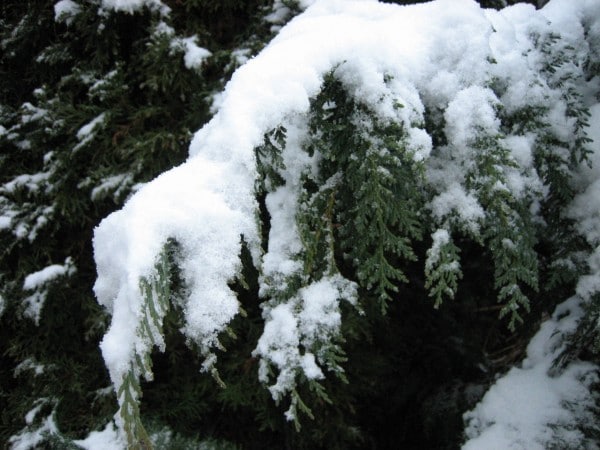
Despite the surprisingly warm days this week, it’s smart to consider what we can do to protect needle and broadleaf evergreen plants from winter injuries. Evergreen shrubs and trees might give the impression that they’re tough and resilient, but the truth is these plants require as much consideration as tender perennials, and need regular watering and an annual feeding to keep them in good condition. With good care through the growing season, they’re much better prepared to withstand severe winter cold. Regular watering during the growing season is the single most important factor in strong winter hardiness for all plants, including evergreens.
When plants are growing within their hardiness zone, cold air temperatures are unlikely to cause winter damage. However, the weight of crushing snow and ice is one hazard for coniferous shrubs; chronic exposure to extreme wind chill in exposed locations is another. When conifers accumulate large amounts of snow during winter storms, it’s worth getting out there with a broom to lightly push the accumulation off to reduce the weight on frozen branches. This is easy to do by putting the flat side of a broom on the underside of branches and gently bouncing them upward to dislodge snow. Never press downward on branches, as they are brittle and easily snap when frozen.
Where conifers are constantly buffeted by winter wind, a windbreak will offer significant protection. A living windbreak of trees, such as spruce and juniper, are better able to withstand the blast, and can form a shelter belt for more susceptible evergreen species. A more immediate and still reliable solution is to tie evergreen branches and discarded Christmas trees to the exposed sides of evergreens susceptible to wind damage, providing them with some insulation.
By far the most common winter injury is desiccated foliage (the loss of internal moisture in foliage tissues) on plants growing in locations with exposure to south and southwest sunlight and wind. Evergreens with lots of black or brown dead spots in spring have most likely been exposed to strong winter sunlight, sufficiently warm for a few hours at midday to stimulate biological activity in foliage and in the cambium layer under the bark. When the sun goes down, air temperature rapidly drops and tender tissues are caught in a sudden deep freeze. With a frozen root system unable to pump water, tissue death and split bark are the resulting injuries. This process of quick warming and sudden freezing is repeated every sunny day, and consequently damage to plants can be severe.
Yew, cedar and hemlock, and broadleaf evergreens such as boxwood and rhododendrons are most susceptible to desiccation. Anti-desiccant sprays provide a protective waxy coating and can be applied in late autumn. These aren’t entirely effective, sometimes flaking off before winter is over. The best solution is to provide shade from direct sunlight on foliage and bark by erecting a shade barrier with stakes and burlap. Surround the plant on three or four sides, without letting the burlap touch the branches, and without covering the top. Wrapping plants tightly in burlap will cause more problems by cutting off circulation and compressing frozen branches.
Protect tree trunks in late autumn by wrapping them with any light-coloured material or reflective wrap (available at garden centres). Remove wrappings in late spring. The idea is to keep plants cold and shaded, so foliage will remain dormant and inactive.
It’s a good feeling to know vulnerable plants are suited up and ready for their winter exposure. Needless to say, the gardener should be well wrapped and parked by a toasty fire for the duration.









this is a good article, because we never think of protecting and deep watering evergreens in October so they can survive the winter.
Please rite or send me a clip on how to make more “boxwood” cuttings so I can get a nice short hedge around my garden perennials, they are so expensive.
I really enjoy Garden Making!